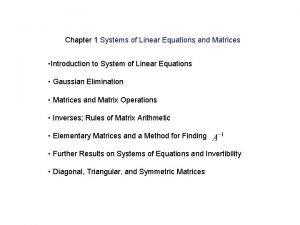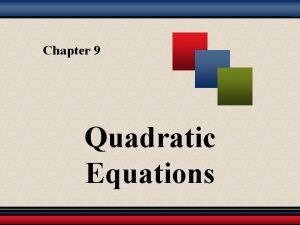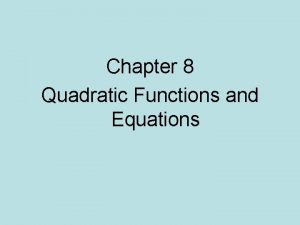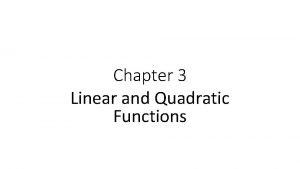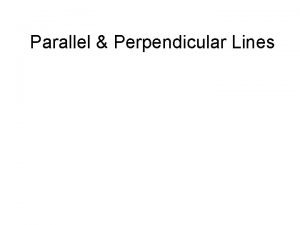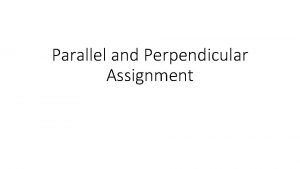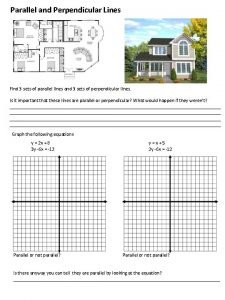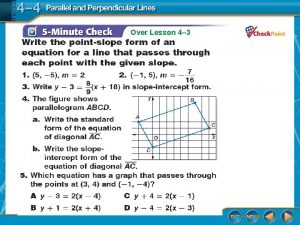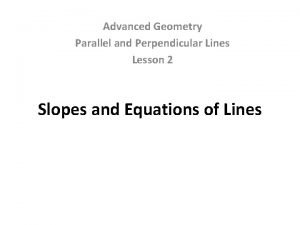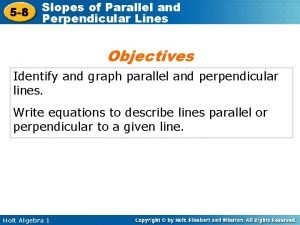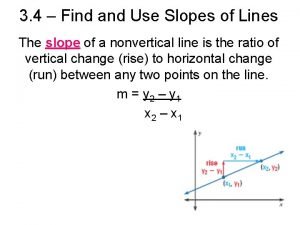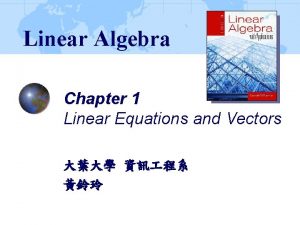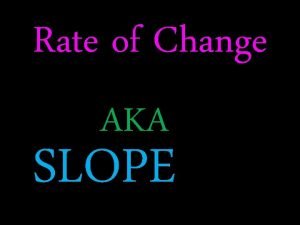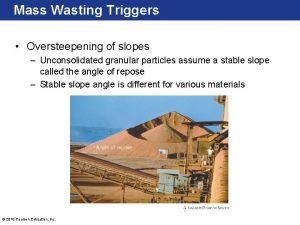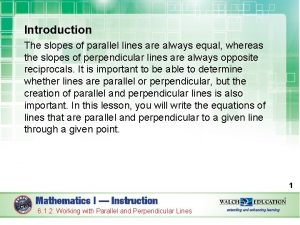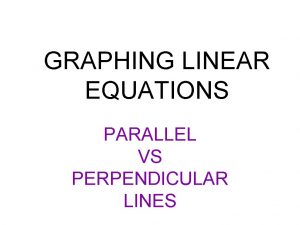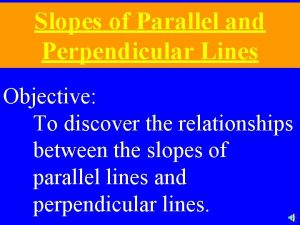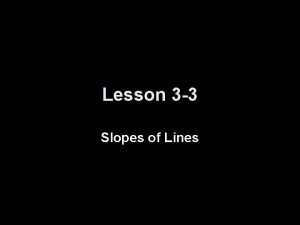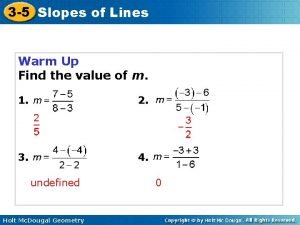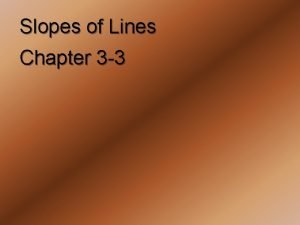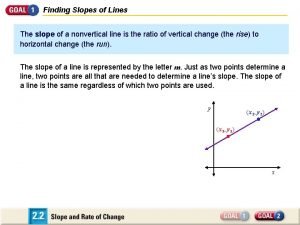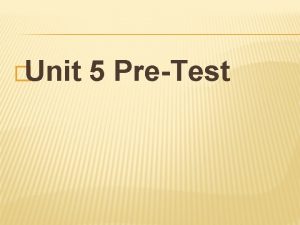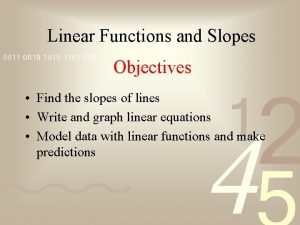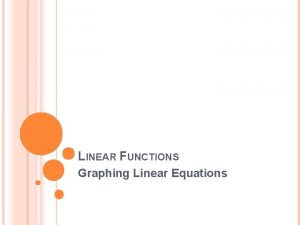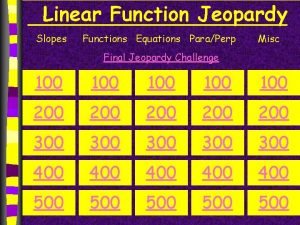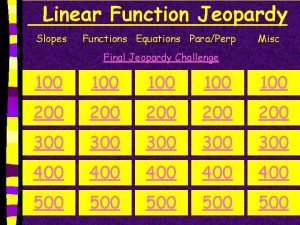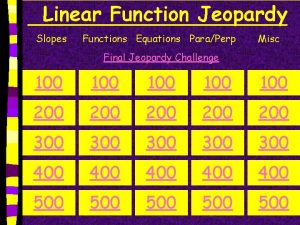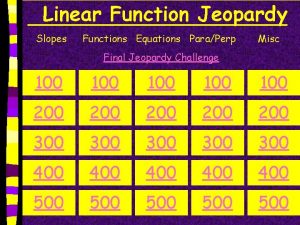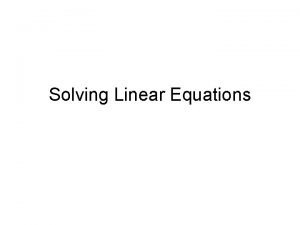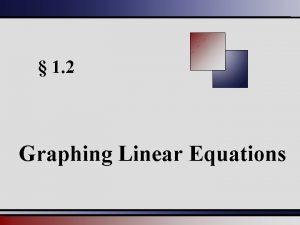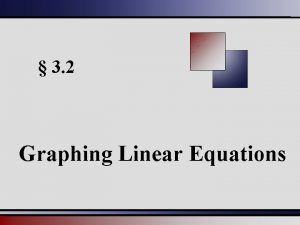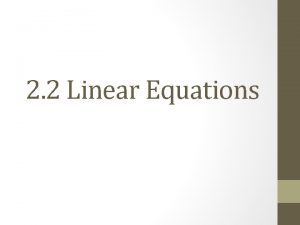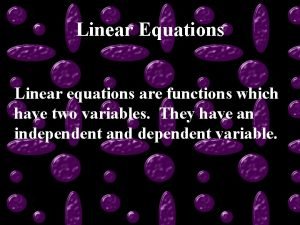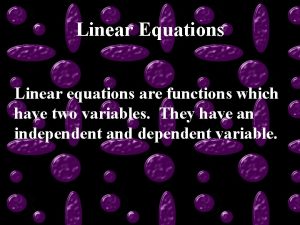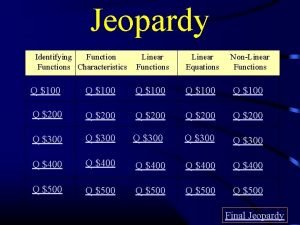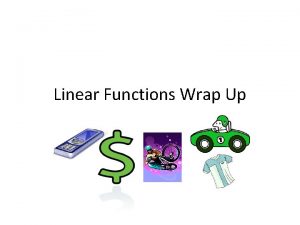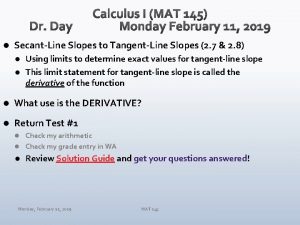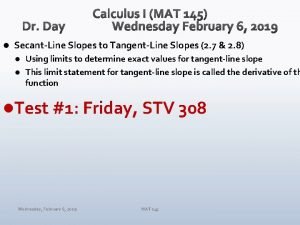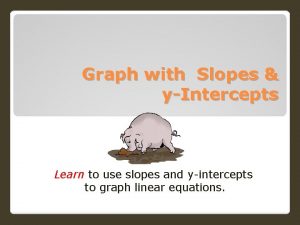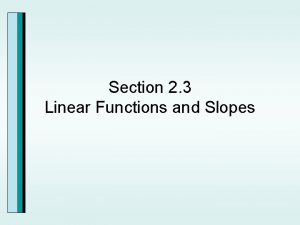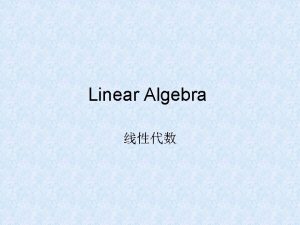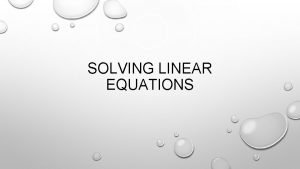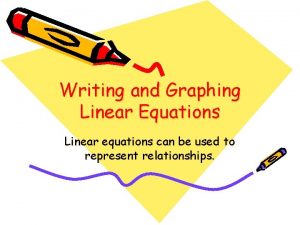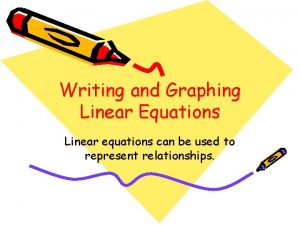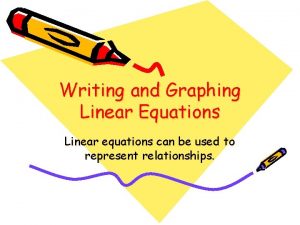Chapter 1 Linear Functions Slopes and Equations of





























- Slides: 29

Chapter 1 Linear Functions

Slopes and Equations of Lines l The Rectangular Coordinate System – – – The horizontal number line is the x-axis The vertical number line is the y-axis The point where the axes intersect is the origin (the 0 point)

Slopes and Equations of Lines l The point given as (2, 3) is also called an ordered pair. – – Where 2 is the x coordinate, the first coordinate, the abscissa, or the horizontal distance Where 3 is the y coordinate, the second coordinate, the ordinate, or the vertical distance

Slopes and Equations of Lines l Intercepts of a Line – – The y-intercept of a line is the point (0, b) where the line intersects the y axis. To find b, substitute 0 for x in the equation of the line and solve for y. The x-intercept of a line is the point (a, 0) where the line intersects the x-axis. To find a, substitute 0 for y in the equation of a line and solve for x.

Slopes and Equations of Lines l Slope – – Slope (m) is a measure of the slant of a line. The slope of the line between two points is the ratio of the change in y to the change in x.

Slopes and Equations of Lines – The slope of a line is defined as the vertical change (the “rise”) over the horizontal change (the “run”) as one travels along the line.

Slopes and Equations of Lines l Slope of a Line

l Point-Slope Form of the Equation of a Line Slopes and Equations of Lines Recall the slope-intercept from of a line is – l Y = mx + b – where m is slope and b is the y-intercept CASE A GIVEN A POINT AND THE SLOPE – The equation of the line passing through P(x 1, y 1) and with slope m is l l y – y 1 = m( x – x 1 ) (the point-slope formula) So given a slope and a point (other than y-intercept) – We replace m with the given slope – We replace x 1 and y 1 with the point coordinates – Simplify – Write the equation in the form of y = mx + b

Slopes and Equations of Lines CASE B GIVEN TWO POINTS ONLY – The equation of the line passing through P(x 1, y 1) and P(x 2, y 2) (slope is not given) l l We first use the slope formula to determine slope Then we use one of the given points and the slope in the pointslope formula y – y 1 = m( x – x 1 )

Slopes and Equations of Lines CASE C GIVEN A POINT P(x 1, y 1) AND AN UNDEFINED SLOPE – – – Recall that a line with an undefined slope is a vertical line with x = a, where a is the x-coordinate of the x-intercept (x 1, 0) Recall that for a vertical line, the x-coordinate doesn’t change. the equation would simply be x = x 1

Slopes and Equations of Lines CASE D GIVEN A POINT P(x 1, y 1) AND A ZERO SLOPE – – – Recall that a line with a zero slope is a horizontal line with y = b, where b is the y-coordinate of the y -intercept (0, b) Recall that for a horizontal line, the y-coordinate doesn’t change. the equation would simply be y = y 1

Slopes and Equations of Lines CASE E GIVEN THE Y-INTERCEPT (0, b) AND SLOPE – We use the slope-intercept form l y = mx +b Replace m with the given slope – Replace b with the given y-coordinate –

Slopes and Equations of Lines l Slopes of Horizontal and Vertical Lines – – l horizontal lines (y = b) have a slope of 0 vertical lines (x = a) have no defined slope Slopes of Parallel Lines – Two nonvertical lines are parallel if they have the same slope (they do not intersect) l l (i. e. , line A has slope of 1/2 and line B has a slope of 1/2) Slopes of Perpendicular Lines – Two nonvertical lines are perpendicular if their slopes are negative reciprocals of each other. These lines intersect at right angles l (i. e. , line A has slope of 1/2 and line B has a slope of -2)

Slopes and Equations of Lines l Finding equations of parallel and perpendicular lines l l To find equations of parallel and perpendicular lines we always need to know slope. Recall that parallel lines ( ) – two lines that do not intersect - have the same slope. – perpendicular lines ( ) – two lines that intersect at right angles – have slopes that are negative reciprocals of each other. –

Slopes and Equations of Lines l Example – Find the equation of a line containing the point (3, 2) and to the line 3 x + y = -3. l l To be parallel, the lines must have the same slope. The line 3 x + y = -3 has a slope of -3 because when we solve for y : y = -3 x -3 Given a point (3, 2) and a slope -3 we use the point-slope formula – l y – y 1 = m( x – x 1 ) The equation is y = -3 x + 11

l Example Slopes and Equations of Lines – Find the equation of a line containing the point (-1, -3) and to the line 3 x - 5 y = 2. l To be perpendicular, the lines must have slopes that are negative reciprocals of each other. The line 3 x - 5 y = 2 has a slope of 3/5 because when we solve for y : – l l y = 3/5 x -2/5 The slope of the other line has to be -5/3 Given a point (-1, -3) and a slope -5/3 we use the point-slope formula – y 1 = m( x – x 1 ) l The equation is y = -5/3 x – 14/3

l Graphing Lines Slopes and Equations of Lines – To graph an equation in two variables such as y = x – 1 when x = -2, -1, 0, 1, 2. l Using Substitution Substitute each value of x into the equation. – Solve for y – Graph the ordered pairs – l Using slope and y-intercept Place a point at the y-intercept – Starting from the y-intercept, “rise” then “run” based on slope –

Linear Functions And Applications l Linear Functions – Notation – f(x) l – Note: f, g, or h are often used to name functions The function f(x) is defined by l y = f(x) = mx + b

Linear Functions And Applications Operations l Linear Functions The sum of f and g, denoted as f + g, is defined by (f + g)(x) = f(x) + g(x) The difference of f and g, denoted as f – g, is defined by (f – g)(x) = f(x) – g(x) The product of f and g, denoted as f∙g, is defined by (f∙g)(x) = f(x)g(x) The quotient of f and g, denoted as f/g, is defined by (f/g)(x) = where g(x) 0

Linear Functions And Applications l Example – Let f(x) = 4 x – 1. Find f(-2), f(-1), f(0), f(1), f(2) f(-2) = 4(-2) – 1 = -8 – 1 = -9 f(-1) = 4(-1) – 1 - -4 – 1 = -5 f(0) = 4(0) – 1 = 0 -1 = -1 f(1) = 4(1) – 1 = 4 – 1 = 3 f(2) = 4(2) – 1 = 8 – 1 = 7

Linear Functions And Applications l Supply and Demand – Supply and Demand functions are not necessarily linear l – Most approximately linear Equilibrium Price/Quantity l l Equilibrium price of a commodity is the price found at the point where the supply and demand are equal (i. e. , where the supply and demand graphs for that commodity intersect). Equilibrium quantity is the quantity where the prices from both demand the supply are equal.

Linear Functions And Applications l Cost Analysis – The cost of manufacturing an item commonly consists of two parts: l Fixed cost – designing the product, setting up a factory, training workers, etc. l Marginal cost – approximates the cost of producing one additional item.

Linear Functions And Applications l Cost Analysis – The Cost Function l C(x) = mx + b where m represents marginal cost per item where b represents the fixed cost

Linear Functions And Applications l Break-Even Analysis – – – Involves both revenue and profit. Revenue R(x) = px where p represents the price per unit of product where x represents the number of units sold (demand) Profit P(x) is the difference between revenue and cost: l l l P(x) = R(x) – C(x) Break-even quantity – the number of units at which revenue just equals cost Break-even point – the point where revenue equals cost.

The Least Squares Line l In practice, how are equations of supply and demand functions found? – – Data is collected Data is plotted l l Data lie perfectly along a line – equation easily found using any two points Data scattered and no line that goes through all points – must find a line that approximates the linear trend of the data as closely as possible (Method of Least Squares)

l How do we know when we. Line have the best line The Least Squares (least squares line) ? (see Figure 16, p. 30) – The line whose sum of squared vertical distances from the data points is as small as possible. l The least squares line Y = mx + b, where and or

The Least Squares Line l Calculating by hand – Given “n” pairs of data, find the required sums. x y 2 y xy x 2 _________________________ x y xy x 2 y 2 – – Plug and Chug Write least squares equation in the form of Y = mx + b.

The Least Squares Line l Coefficient of Correlation – Measures of “goodness of fit” of the least squares line

The Least Squares Line – – – The coefficient of correlation (r) is always equal to or between 1 and -1. Coefficient of correlation (r) values of exactly 1 or -1 mean that the data points lie exactly on the least squares line. If r = 1, the least squares line has a positive slope If r = -1, the least squares line has a negative slope If r = 0, there is no linear correlation between the data points (some nonlinear function might provide a better fit) The closer the value of r is to 1 or -1, the stronger the linear relationship between the data points.
 Simultaneous equations linear and non linear
Simultaneous equations linear and non linear Difference between linear and non linear equations
Difference between linear and non linear equations Persamaan linear simultan
Persamaan linear simultan Homogeneous system of linear equations examples
Homogeneous system of linear equations examples Chapter 9 quadratic equations and functions
Chapter 9 quadratic equations and functions Chapter 8 quadratic functions and equations answer key
Chapter 8 quadratic functions and equations answer key Chapter 3 linear and quadratic functions
Chapter 3 linear and quadratic functions Perpendicular lines
Perpendicular lines Slopes of parallel and perpendicular lines
Slopes of parallel and perpendicular lines Slopes of parallel and perpendicular lines assignment
Slopes of parallel and perpendicular lines assignment 3 sets of parallel lines
3 sets of parallel lines Slopes of parallel and perpendicular lines lesson 8-1
Slopes of parallel and perpendicular lines lesson 8-1 If line a contains q(5 1)
If line a contains q(5 1) What slope is perpendicular to 5/8
What slope is perpendicular to 5/8 Find and use slopes of lines
Find and use slopes of lines Multi step equations vocabulary
Multi step equations vocabulary Linear algebra chapter 1
Linear algebra chapter 1 Chapter 3 graphing linear functions answer key
Chapter 3 graphing linear functions answer key Type of slopes
Type of slopes Fast movement
Fast movement The slopes of parallel lines are always
The slopes of parallel lines are always Perpendicular vs parallel equations
Perpendicular vs parallel equations Emigree structure
Emigree structure Two lines are parallel if their slopes are
Two lines are parallel if their slopes are Lesson 3-5 slopes of lines answer key
Lesson 3-5 slopes of lines answer key 3-5 slopes of lines
3-5 slopes of lines If line a contains q(5 1)
If line a contains q(5 1) Might fly our lives like paper kites
Might fly our lives like paper kites Slopes of lines
Slopes of lines No slope
No slope



